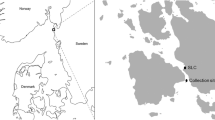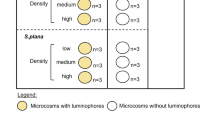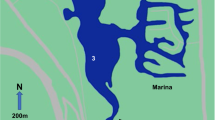Abstract
To assess the effects of feeding and bioturbation by the sand dollar Encope emarginata on microphytobenthic structure, we have carried out a 10-day factorial mesocosm experiment. Four treatments were applied to discriminate between biological (feeding) and physical (bioturbation) effects: (i) with live E. emarginata, in which grazing and bulldozing activities occurred; (ii) without sand dollars but subjected to artificial disturbance simulating mechanical bioturbation effects; (iii) with dead calcareous skeletons, in which neither feeding nor bioturbation occurred; and (iv) without live or dead individuals. Bioturbation negatively affected microphytobenthic assemblages, as indicated by the lower overall microalgal cell densities in “live E. emarginata” and “artificial disturbance.” Densities of Nitzschia spp. (pennate, <20 µm) were higher in “without E. emarginata,” whereas densities of Auliscus sp. (centric, >20 µm) were higher in “live E. emarginata,” indicating that sand dollar disrupted the <20 µm biofilm, favoring larger diatoms. Higher densities of Nitzschia spp. in “artificial disturbance” compared with “live E. emarginata” indicated that sand dollar selectivity for smaller food items acts synergistically with bulldozing in structuring microphytobenthos. Thus, both trophic and engineering processes mediated by E. emarginata influence microphytobenthic structure. Our results highlight the importance of complex interactions among different-sized species in structuring benthic assemblages.


Similar content being viewed by others
References
Alvarez, M. F., K. S. Esquius, M. Addino, J. Alberti, O. Iribarne & F. Botto, 2013. Cascading top-down effects on estuarine intertidal meiofaunal and algal assemblages. Journal of Experimental Marine Biology and Ecology 440: 216–224.
Anderson, M. J., 2001. A new method for non-parametric multivariate analysis of variance. Austral Ecology 26: 32–46.
Anderson, M. J. & J. Robinson, 2003. Generalized discriminant analysis based on distances. Australian and New Zealand Journal of Statistics 45: 301–318.
Braeckman, U., P. Provoost, B. Gribsholt, D. Van Gansbeke, J. J. Middelburg, K. Soetaert, M. Vincx & J. Vanaverbeke, 2010. Role of macrofauna functional traits and density in biogeochemical fluxes and bioturbation. Marine Ecology Progress Series 399: 173–186.
Brustolin, M. C., M. C. Thomas, L. L. Mafra & P. C. Lana, 2014. Does Encope emarginata (Echinodermata: Echinoidea) affect spatial variation patterns of estuarine subtidal meiofauna and microphytobenthos? Journal of Sea Research 91: 70–78.
Camargo, M. G., 2006. SysGran: um sistema de código aberto para análises granulométricas do sedimento. Revista Brasileira de Geociências 36: 371–378.
Cartaxana, P., C. R. Mendes, M. A. van Leeuwen & V. Brotas, 2006. Comparative study on microphytobenthic pigments of muddy and sandy intertidal sediments of the Tagus estuary. Estuarine Coastal and Shelf Science 66: 225–230.
Cartaxana, P., M. Ruivo, C. Hubas, I. Davidson, J. Serôdio & B. Jesus, 2011. Physiological versus behavioral photoprotection in intertidal epipelic and epipsammic benthic diatom communities. Journal of Experimental Marine Biology and Ecology 405: 120–127.
Challener, R., M. Miller, D. Furbish & J. McClintock, 2009. Evaluation of sand grain crushing in the sand dollar Mellita tenuis (Echinoidea: Echinodermata). Aquatic Biology 7: 261–268.
Dana, J. D., 1851. Crustacea Grapsoidea, (Cyclometopa, Edwardsii): Conspectus Crustacearum quae in Orbis Terrarum circumnavigatione, Carolo Wilkes e classe Reipublicae Foederatae Duce, lexit et descriptsit J. D. Dana. Proceedings of the Academy of Natural Sciences of Philadelphia 5: 247–254 (printed in 1852).
de Deckere, E. M. G. T., T. Tolhurst & J. F. De Brouwer, 2001. Destabilization of cohesive intertidal sediments by infauna. Estuarine Coastal and Shelf Science 53: 665–669.
de Jonge, V. N. & J. F. F. van Beusekom, 1995. Wind- and tide induced resuspension of sediment and microphytobenthos from tidal flats in the Ems estuary. Limnology and Oceanography 40: 766–778.
d’Orbigny, A., 1835. Synopsis terrestrium et fluviatilium molluscorum, in suo per Americam meridionalem itinere. Magasin de Zoologie 5: 1–44.
Giberto, D. A., C. S. Bremec, E. M. Acha & H. Mianzan, 2004. Large-scale spatial patterns of benthic assemblages in the SW Atlantic: the Río de la Plata estuary and adjacent shelf waters. Estuarine Coastal and Shelf Science 61: 1–13.
Gilbertson, W. W., M. Solan & J. I. Prosser, 2012. Differential effects of microorganism-invertebrate interactions on benthic nitrogen cycling. FEMS Microbial Ecology 82: 11–22.
Guilherme, P. D. B., M. C. Brustolin & M. L. Bueno, 2015. Distribution patterns of ectosymbiont crabs and their sand dollar hosts in a subtropical estuarine sandflat. Revista de Biología Tropical 63(2): 209–220.
Hagerthey, S. E., E. C. Defew & D. M. Paterson, 2002. Influence of Corophium volutator and Hydrobia ulvae on intertidal benthic diatom assemblages under different nutrient and temperature regimes. Marine Ecology Progress Series 245: 47–59.
Hewitt, J. E., S. F. Thrush, P. Legendre, V. J. Cummings & A. Norkko, 2002. Integrating heterogeneity across spatial scales: interactions between Atrina zelandica and benthic macrofauna. Marine Ecology Progress Series 239: 115–128.
Kwon, H. K., S. J. Oh & H. Yang, 2013. Growth and uptake kinetics of nitrate and phosphate by benthic microalgae for phytoremediation of eutrophic coastal sediments. Bioresource Technology 129: 387–395.
Kristensen, E., G. Penha-Lopes, M. Delefosse, T. Valdemarsen, C. Quintana & G. Banta, 2012. What is bioturbation? The need for a precise definition for fauna in aquatic sciences. Marine Ecology Progress Series 446: 285–302.
Lange, K., A. Liess, J. J. Piggott, C. R. Townsend & C. D. Matthaei, 2011. Light, nutrients and grazing interact to determine stream diatom community composition and functional group structure. Freshwater Biology 56: 264–278.
Leske, N. G., 1778. Additamenta ad Jacobi Theodori Klein naturalem dispositionem echinodermatum et lucubratiunculam de aculeis echinorum marinorum. Gleditsch, Leipzig, xx+278 pp., 54 pls.
Linnaeus, C., 1758. Systema Naturae. Editio decima. 1. Regnum Animale Holmiae. Laurentii Salvii, 824 pp.
Lohrer, A. M., S. F. Thrush & M. M. Gibbs, 2004. Bioturbators enhance ecosystem function through complex biogeochemical interactions. Nature 431: 1092–1095.
Mermillod-Blondin, F. & R. Rosenberg, 2006. Ecosystem engineering: the impact of bioturbation on biogeochemical processes in marine and freshwater benthic habitats. Aquatic Sciences 68: 434–442.
Ni Longphuirt, S., A. Leynaert, J. Guarini, L. Chauvaud, P. Claquin, O. Herlory, E. Amice, P. Huonnic & O. Ragueneau, 2006. Discovery of microphytobenthos migration in the subtidal zone. Marine Ecology Progress Series 328: 143–154.
Oksanen, J., G. F. Blanchet, R. Kindt, P. Legendre, R. B. O`Hara, G. L. Simpson, P. Solymos, M. H. H. Stevens & H. Wagner, 2011. Vegan: Community Ecology Package. R package version 1.17-7. http://CRAN.R-project.org/package=vegan.
Ólafsson, E., J. Ullberg & N. Arroyo, 2005. The clam Macoma balthica prevents in situ growth of microalgal mats: implications for meiofaunal assemblages. Marine Ecology Progress Series 298: 179–188.
Orvain, F., K. Guizien, S. Lefebvre, M. Bréret & C. Dupuy, 2014. Relevance of macrozoobenthic grazers to understand the dynamic behavior of sediment erodability and microphytobenthos resuspension in sunny summer conditions. Journal of Sea Research 92: 46–55.
Passarelli, C., C. Hubas, S. A. Nicolas, J. Grange & T. Meziane, 2012. Surface adhesion of microphytobenthic biofilms is enhanced under Hediste diversicolor (O.F. Müller) trophic pressure. Journal of Experimental Marine Biology and Ecology 438: 52–60.
Passarelli, C., F. Olivier, D. Paterson, T. Meziane & C. Hubas, 2014. Organisms as cooperative ecosystem engineers in intertidal flats. Journal of Sea Research 92: 92–101.
Perkins, R. G., J. Lavaud, J. Serôdio, J. L. Mouget, P. Cartaxana, P. Rosa, L. Barillé, V. Brotas & B. M. Jesus, 2010. Vertical cell movement is a primary response of intertidal benthic biofilms to increasing light dose. Marine Ecology Progress Series 416: 93–103.
Reise, K., 2002. Sediment mediated species interactions in coastal waters. Journal of Sea Research 48: 127–141.
Ribeiro, L., V. Brotas, Y. Rincé & B. Jesus, 2013. Structure and diversity of intertidal benthic diatom assemblages in contrasting shores: a case study from the Tagus estuary. Journal of Phycology 49: 258–270.
Saburova, M. A. & I. G. Polikarpov, 2003. Diatom activity within soft sediments: behavioural and physiological processes. Marine Ecology Progress Series 251: 115–126.
Sahan, E., K. Sabbe, V. Créach, G. Hernandez-Raquet, W. Vyverman, L. J. Stal & G. Muyzer, 2007. Community structure and seasonal dynamics of diatom biofilms and associated grazers in intertidal mudflats. Aquatic Microbial Ecology 47: 253–266.
Taylor, J. D., B. A. McKew, A. Kuhl, T. J. McGenity & G. J. C. Underwood, 2013. Microphytobenthic extracellular polymeric substances (EPS) in intertidal sediments fuel both generalist and specialist EPS-degrading bacteria. Limnology and Oceanography 58(4): 1463–1480.
Underwood, G. J. C. & D. M. Paterson, 1993. Recovery of intertidal benthic diatoms after biocide treatment and associated sediment dynamics. Journal of Marine Biological Association of the United Kingdom 73: 25–45.
Acknowledgements
Our thanks to all friends, staff, and faculty from the Center for Marine Studies (CEM/UFPR) and from the Zoology Department (UFPR) and to the staff at the Benthos and Microalgae Laboratory (CEM/UFPR) and Isotopic Ecology Laboratory (CENA/USP). We also thank Sergio Antonio Netto (Laboratory of Marine Sciences/Unisul), Fabiane Gallucci (Federal University of São Paulo/UNIFESP), and Luciano Felício Fernandes (UFPR) for logistical and intellectual support. We thank also a number of anonymous reviewers for their critical comments on the manuscript. This study was funded by the Coordination for the Support of Research and Higher Education (CAPES) and the National Council for Scientific and Technological Development of Brazil (CNPq), which provided scholarships and grants to the authors. This manuscript was partially edited by a professional science editor and a native English-speaking researcher.
Author information
Authors and Affiliations
Corresponding author
Additional information
Handling editor: Stuart Jenkins
Electronic supplementary material
Below is the link to the electronic supplementary material.
Rights and permissions
About this article
Cite this article
Brustolin, M.C., Thomas, M.C., Mafra, L.L. et al. Bioturbation by the sand dollar Encope emarginata (Echinoidea, Mellitidae) changes the composition and size structure of microphytobenthic assemblages. Hydrobiologia 779, 183–192 (2016). https://doi.org/10.1007/s10750-016-2815-6
Received:
Revised:
Accepted:
Published:
Issue Date:
DOI: https://doi.org/10.1007/s10750-016-2815-6




